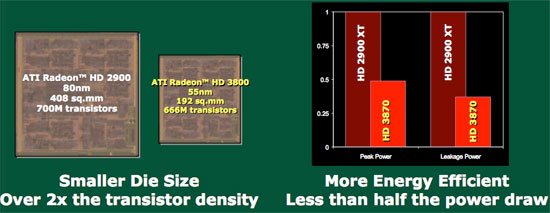ATI Radeon HD 3870 & 3850: A Return to Competition
by Anand Lal Shimpi & Derek Wilson on November 15, 2007 12:00 AM EST- Posted in
- GPUs
Finally. We're finally getting somewhere interesting in the graphics industry. Although they're sure to return, the days of reviewing $600 graphics card after $600 graphics card are on hiatus, and instead we're reviewing a new class of mainstream cards with earth-shattering performance.
NVIDIA's GeForce 8800 GT kicked off the trend, in one fell swoop making almost all of NVIDIA's product line obsolete thanks to the high performance and low price tag (we'll talk about that last part shortly). But what we saw there wasn't a fluke, it was a preemptive strike against AMD, who have been hard at work on an affordable GPU of their own.
This new product, like the 8800 GT, would be aimed squarely at the $150 - $250 market segment, something both AMD and NVIDIA did a horrible job at with mainstream releases earlier this year (2600 and 8600 both sucked guys).
Introducing the RV670
AMD's two new graphics cards launching today are both based off a new GPU, referred to internally as the RV670. The basic architecture of the hardware is largely unchanged from R600; there has been some additional functionality added, and a great deal of internal bandwidth removed, but other than that this is very much an R600 based part.

The biggest news of this part is that it is fabbed on a 55nm TSMC process. This is a half-node process based on 65nm technology, giving AMD an advantage in die size (cost) and potentially clock speed and/or power.

Historically, AMD's RV series has been a cost cut version of their R series designed for lower end volume parts, and that's where RV670 started. Right of the bat, half the external and internal memory bandwidth of R600 was cut out. External bandwidth dropped from 512-bit to 256-bit, but AMD stuck with 8 memory channels (each dropped from 64bit to 32bit).
Internally, the ring bus dropped from 1024-bit to 512-bit. This cut in bandwidth contributed to a significant drop in transistor count from R600's ~720M. RV670 is made up of 666M transistors, and this includes the addition of UVD hardware, some power saving features, the necessary additions for DX 10.1 and the normal performance tuning we would expect from another iteration of the architecture.

Processing power remains unchanged from the R600; the RV670 features 320 stream processors, 16 texture units and 16 redner back-ends. Clock speeds have gone up slightly and memory speeds have increased tremendously to make up for the narrower memory bus.
The RV670 GPU is also fully PCI Express 2.0 compliant like NVIDIA's G92, the heart and soul of the GeForce 8800 GT.










117 Comments
View All Comments
Agent11 - Sunday, November 18, 2007 - link
I was very disappointed with the use of a p35 chipset to compare crossfire to SLI.You use a motherboard with 16x by 16x pcie lanes for SLI but use one with 16x by 4x for crossfire... And then make a point of crossfire not scaling as well!
Ask any bencher, it does matter.
SmoulikNezbeda - Sunday, November 18, 2007 - link
Hi,I would like to know what numbers in graphs really represents. Are those average FPS or something like (min + max + ave)/3 FPS?
Thanks
Agent11 - Monday, November 19, 2007 - link
If it isn't average then theres a problem.wecv - Monday, August 14, 2017 - link
Hello, I am from the future.We now have 2GB GPUs with GDDR5 as entry level, 4GB-8GB GPUs for midrange with GDDR5 and 8GB GDDR5/GDDR5X/HBM2 or 11GB GDDR5X for High-end and enthusiast!
You may go and live back in the past.
TheOtherRizzo - Saturday, November 17, 2007 - link
What would you need a frame buffer of 512 MB for? That's enough room for about 80 1080p images. Sounds to me like someone at ATI is stuck in 1994 when framebuffers were the only memory on a graphics card...wecv - Monday, August 14, 2017 - link
Hello, I am from the future.We now have 2GB GPUs with GDDR5 as entry level, 4GB-8GB GPUs for midrange with GDDR5 and 8GB GDDR5/GDDR5X/HBM2 or 11GB GDDR5X for High-end and enthusiast!
You may go and live back in the past.
ZipFreed - Friday, April 13, 2018 - link
Lol, this comment is awesome and cracked me up. I am reading these older GPU reviews researching something and have been thinking similar sentiments to myself as I go.Glad you necro'd this.
0roo0roo - Saturday, November 17, 2007 - link
the convoluted naming systems of gpus garrantees pretty much only geeks in the know will make good purchasing decisions. this matters to the health of the pc game industry, i'm sure many have been turned off by the experience of going to their local store and buying a card within their budget and little other useful information and getting a lousy experience. i'm sure retailers actually benifit from the confusion since they can charge more and just hope the customer just bases their decision on their price range.Shark Tek - Saturday, November 17, 2007 - link
Finally GPU manufacturers are thinking right. Instead of making oven like heaters power hogs GPUs they're trying to make things right like Intel and AMD are doing with their CPU lines with less heat and power consumption.Lets see the upcoming generations how they will perform. ;)
araczynski - Friday, November 16, 2007 - link
I'm assuming this is a mid line card with better stuff coming out?otherwise I don't see the point of getting anything other than an 8800gt, prices are too close to give up top of the line for merely 60 or so bucks, or better yet, waiting a few more months till the 8900's roll out.